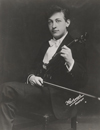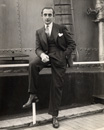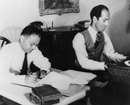All material found in the Press Releases section is provided by parties entirely independent of Musical America, which is not responsible for content.
Press Releases
Brooklyn Youth Chorus to present world premiere of Port(al), a site-specific performance exploring the history of the Brooklyn Navy Yard
FOR IMMEDIATE RELEASE - February 14, 2025 - The GRAMMY Award-winning Brooklyn Youth Chorus (Founder & Artistic Director Dianne Berkun Menaker) presents the world premiere of Port(al), an ambitious new project—a performance installation, and a living museum—that continues to expand Brooklyn Youth Chorus’s dynamic vision for its live programming (beginning May 1, 2025). Engaging young singers in world-class art-making and bringing their ideas to the center of the creative process, Port(al) considers the history of the Brooklyn Navy Yard and the connective possibilities of port cities, in tandem with choristers’ anxieties about and hopes for our present and future. A site-specific work reawakening history in the goliath raw space of the Navy Yard’s Agger Fish building, Port(al) brings co-composer Paola Prestini (co-founder and artistic director of National Sawdust, and a close friend of Brooklyn Youth Chorus), co-composer and co-librettist Jad Abumrad (founder and former co-host of Radiolab), and multidisciplinary director and co-librettist Jessica Grindstaff (a co-founder of Phantom Limb Company) into groundbreaking collaboration with Brooklyn Youth Chorus.
Vividly evoking and honoring Brooklyn’s ghosts, Port(al) spins oral histories from recently passed figures like historian Howard Zinn (who worked as an apprentice in the Navy Yard) and activist Clarence L. Irving, Sr. (who had been a riveter in the Navy Yard) into stunning compositions; looks into the legacy of machinist and drag king Rusty Brown; and considers the power of the first live radio singing performance, by mezzo soprano Eugenia Farrar. Reflected in this swirl of text and song, performance, guided audio tour, and séance are the early prison ships that floated in Wallabout Bay and left over 11,500 victims in their wake, all buried near Navy Yard in the early 1800s; Walt Whitman’s “Crossing Brooklyn Ferry”; women’s, immigrants’, and Black Americans’ labor during wartime; the rise of queer culture into the public eye; and more. Ebbing, flowing, and interweaving throughout the piece are the voices of the youth chorus speaking to their relationship to their very own time and place, and their future.
Port(al) follows major Brooklyn Youth Chorus works including Silent Voices (world premiere: BAM), Aging Magician (composed by Prestini; world premiere: Walker Art Center; New York premiere: New Victory Theater), Black Mountain Songs (world premiere: BAM Next Wave Festival), and Tell the Way (world premiere: St. Ann’s Warehouse). Port(al) is the first evening-length work commissioned, developed, produced, and presented entirely by Brooklyn Youth Chorus—and their first major work built for an unconventional performance venue. Port(al) boldly brings Berkun Menaker’s vision for the Chorus into new interdisciplinary territory. Much like Prestini’s earlier work with Brooklyn Youth Chorus, Aging Magician, Port(al) sets the strange fluidity and scope of time to song; and like the meticulously researched documentaries and oral histories Abumrad has crafted for radio, it transports audiences to textured understandings of individual stories and moments. Grindstaff, whose works have considered specific places’ (Antarctica, Fukushima, or the site of the world’s oldest living tree) relationships to a changing globe, here turns her lens on her own city.
The performance anchors themes the Chorus has long considered—identity and history—in the space in which it’s presented, using the Navy Yards’ rich past as a point of departure for exploring the complex social and cultural intersections specific to port cities. Following its world premiere in the Agger Fish building, Brooklyn Youth Chorus intends to bring the work to other port cities, where it can continue to collect oral histories and build layers upon layers of youth choristers’ voices and experiences from around the world—becoming, itself, a site of cross-cultural connection. “The piece starts to sort of serve the role of a port: it flows like information and water and people do in and out of a port and it starts to create community and meaning with this group of young people,” Berkun Menaker describes.
Berkun Menaker sees the Navy Yard as “a little microcosm of the world inside our own borough.” She adds, “Through the Navy Yard, choristers are learning about their own history, the history of the world, and the evolution of how marginalized groups have been treated in our society—and how they’ve shaped it. As we’ve all dug into the past, the more personal and individual stories have taken center stage, rather than the grand movements of history.”
Berkun Menaker brought Prestini back into collaboration with Brooklyn Youth Chorus, and Prestini began brainstorming the creative dream team for the project: “The aspect of oral histories we wanted to mine and the depth with which we wanted to do it led me immediately to Jad, and I’d always wanted to work with Jessica,” says Prestini. “In Aging Magician, we had very porous collaborative roles, and this project is the same. There’s musical collaboration between Jad and me, a textual collaboration between Jad and Jessica. Jad has created sound world compositions with recorded voices for me to then compose music into. And the kids’ own experiences are so central to our collaboration: they have brought into the project a lot of complex emotions around the current state of affairs. The anxiety they carry about the future is profound, and it’s juxtaposed with their hopes and desires—sometimes something as simple and poetic as wanting to do a handstand, or to fly like a seagull. And these join with the anxieties and hopes of those that have filled this space before them.”
Says Abumrad, “All of these successive rounds of people whom America needed to build ships have been in this space and they all have stories — many contradictory. Often you will find somebody who felt this was a liberatory experience; they came to the Navy Yard and found it was filled with possibility. And then you find people who describe it as hell, with the smells and the noise. This place was an engine of social progress, where women and Black Americans were entering the labor force, yet its function was to make things to kill people. The idea that this space holds multitudes of histories and perspectives was interesting to us, and the project became like a séance in a way: you walk into a space and try to listen to the whispers. The piece is, in a way, trying to bring the dead back to life, and have kids respond to them, sing to them, from where they are.”
Says Grindstaff, “It’s hard to think of something more hopeful than a group of young people united and raising their voices to talk about something they care about. When asked what gives them hope in the questionnaire, they said singing with this chorus— over and over and over again. You feel that, and it’s powerful—and part of sharing that feeling with the audience is having this not be a proscenium experience. The audience moves through this space, interacting with the set that’s then animated with voices—both recorded and live. That sound world created from the choristers’ strength and bond envelopes them, and they become part of it.”





 FEATURED JOBS
FEATURED JOBS

 RENT A PHOTO
RENT A PHOTO


